How to avoid getting scamed via emails like the fake Webmail email
Phishing/ScamAlso Known As: Webmail spam
Get free scan and check if your device is infected.
Remove it nowTo use full-featured product, you have to purchase a license for Combo Cleaner. Seven days free trial available. Combo Cleaner is owned and operated by RCS LT, the parent company of PCRisk.com.
What is Webmail email scam?
Phishing attacks are used to obtain sensitive information (e.g., login credentials, credit card details, social security numbers) or deliver malicious software (e.g., ransomware, Trojans). The attackers usually claim to be legitimate, trusted companies, organizations, or other entities.
Cyber criminals commonly use email or text messages to trick recipients into providing sensitive information or installing malware onto their computers.
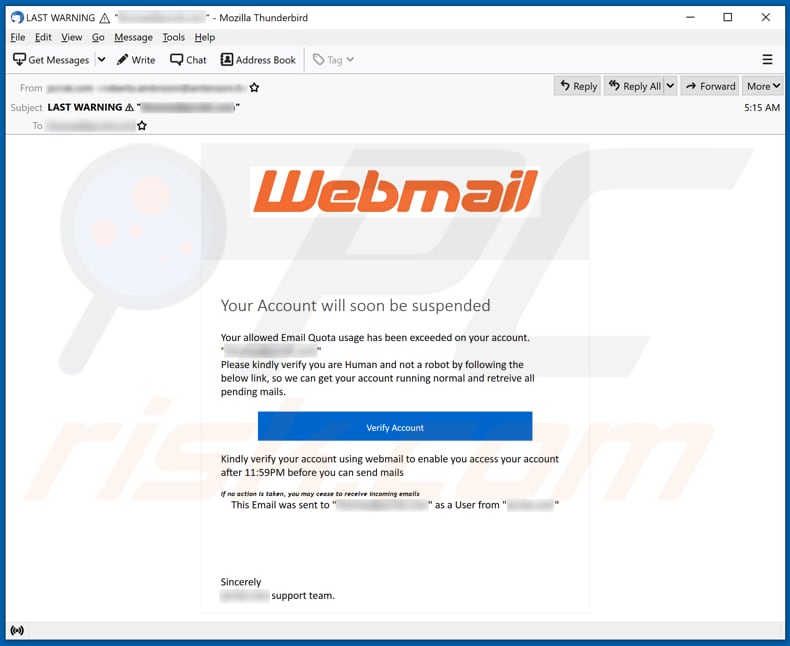
More about the Webmail email scam
This phishing email is designed to appear like a message from the email service provider. It claims that the email account space limit has been exceeded (no more files can be stored in the email account/inbox, which is full) and encourage the user to verify the account as soon as possible, otherwise, new incoming mail will not be delivered.
The main purpose of this phishing email is to trick its recipients into clicking the provided website link and entering their login credentials (email addresses and passwords) on the opened fake Webmail login page. Note that Webmail is a legitimate email service that has nothing to do with this phishing campaign.
By entering their credentials on deceptive websites like this, unsuspecting recipients/users give cyber criminals an opportunity to steal their accounts (in this case, email accounts). Stolen email accounts can be used to send malspam and various scams to trick other users into installing malware onto their computers, sending money, etc.
They can also be used to access all emails that may contain confidential information. Cyber criminals often sell stolen accounts on the darknet, or they try to steal other accounts using the same login credentials as those already stolen.
Therefore, it is important not to enter any credentials or other personal information on websites that are received from suspicious, unknown senders.
| Name | Webmail Email Scam |
| Threat Type | Phishing, Scam, Social Engineering, Fraud |
| Fake Claim | Email quota exceeded |
| Disguise | Last warning from from Webmail |
| Symptoms | Unauthorized online purchases, changed online account passwords, identity theft, illegal access of the computer. |
| Distribution methods | Deceptive emails, rogue online pop-up ads, search engine poisoning techniques, misspelled domains. |
| Damage | Loss of sensitive private information, monetary loss, identity theft. |
| Malware Removal (Windows) |
To eliminate possible malware infections, scan your computer with legitimate antivirus software. Our security researchers recommend using Combo Cleaner. Download Combo CleanerTo use full-featured product, you have to purchase a license for Combo Cleaner. 7 days free trial available. Combo Cleaner is owned and operated by RCS LT, the parent company of PCRisk.com. |
Examples of similar scams
There are many phishing emails circulating on the internet. Some examples are "Federal Ministry Of Health Germany Email Virus", "Consignment Was Booked Via DHL Express Email Virus", "Email Account Is Almost Full Scam", and "Facebook Email Scam".
Typically, they are disguised as important messages from banks, email service providers, couriers, or other entities, and contain an email attachment or a website link used to distribute malware or steal personal information.
How do spam campaigns infect computers?
Typically, cyber criminals behind malspam campaigns send emails with a file attached to them or a download link to the malicious file. Their main goal is to trick recipients into opening/executing the rogue file, which then installs malicious software.
Some examples of files that cyber criminals send via email are Microsoft Office and PDF documents, executables (.exe), JavaScript, and archives (ZIP, RAR).
Note that malicious documents that are opened with Microsoft Office 2010 or newer versions install malicious software only if users enable macros commands (enable editing/content). These versions include "Protected View" mode, which does not allow opened malicious documents to install malware automatically. Older versions do not include this feature and install malicious software without asking permission.
How to avoid installation of malware
Download software and files from official websites and via direct links. It is not safe to use torrent clients, eMule (or other Peer-to-Peer networks), third party downloaders, unofficial websites or other sources of this kind.
Avoid third party installers. Check "Advanced", "Custom" and other settings, and decline offers to download or install unwanted software. Do not click ads that are displayed on dubious websites, since they can open other untrusted websites or even cause unwanted downloads and installations.
Remove any unwanted, suspicious applications (extensions, add-ons, and plug-ins) that are installed on the browser. The same should be applied to programs of this kind that are installed on the operating system.
Regularly scan your computer with reputable antivirus or anti-spyware software and keep this software up to date.
If you have already opened malicious attachments, we recommend running a scan with Combo Cleaner Antivirus for Windows to automatically eliminate infiltrated malware.
Text presented in the Webmail email scam:
Subject: LAST WARNING "********"️
Your Account will soon be suspended
Your allowed Email Quota usage has been exceeded on your account.
"********"
Please kindly verify you are Human and not a robot by following the below link, so we can get your account running normal and retreive all pending mails.Verify Account
Kindly verify your account using webmail to enable you access your account after 11:59PM before you can send mails
If no action is taken, you may cease to receive incoming emails
This Email was sent to "********" as a User from "********"Sincerely
******** support team.
Screenshot of the fake Webmail login page:
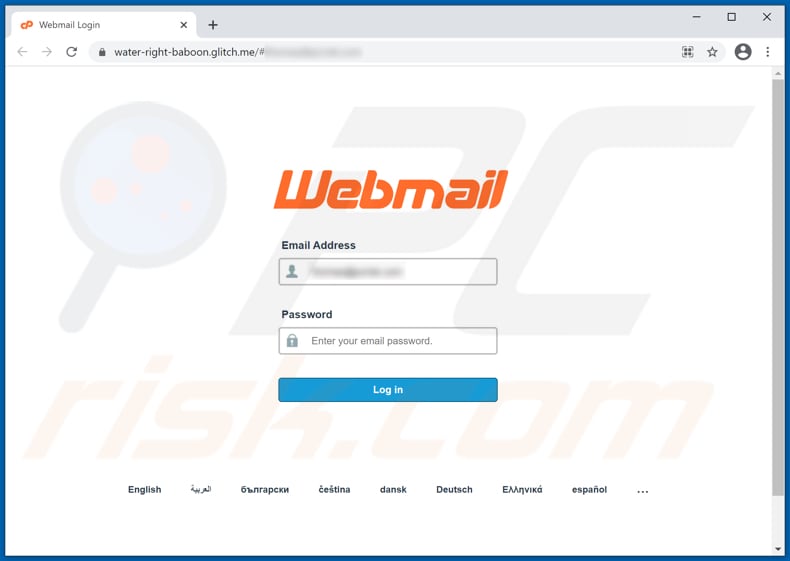
Another Webmail-themed spam email promoting a phishing website:
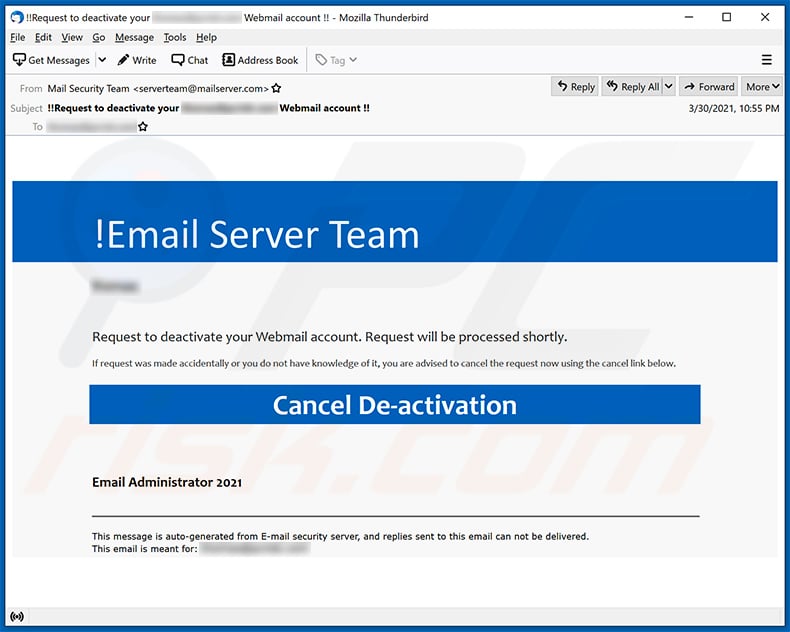
Text presented within:
Subject: !!Request to deactivate your ******** Webmail account !!
!Email Server Team
********
Request to deactivate your Webmail account. Request will be processed shortly.
If request was made accidentally or you do not have knowledge of it, you are advised to cancel the request now using the cancel link below.
Cancel De-activation
Email Administrator 2021
This message is auto-generated from E-mail security server, and replies sent to this email can not be delivered.
This email is meant for: ********
Yet another example of Webmail-themed spam email used to promote a phishing website:
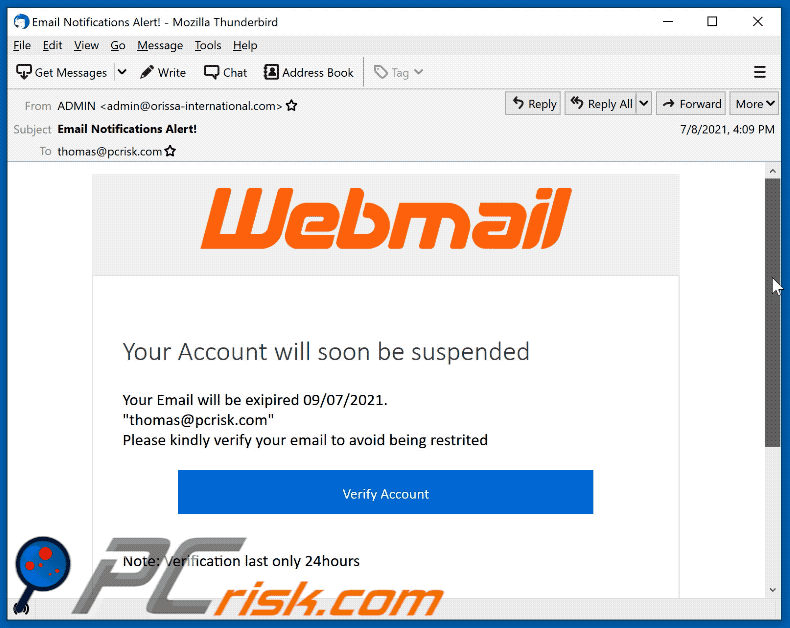
Text presented within:
Subject: Email Notifications Alert!
Webmail
Your Account will soon be suspended
Your Email will be exipired 09/07/2021.
"********"
Please kindly verify your email to avoid being restritedVerify Account
Note: Verification last only 24hours
This Email was sent to "********" as a User from "********"
Sincerely
******** support team.
Screenshot of the promoted phishing site:
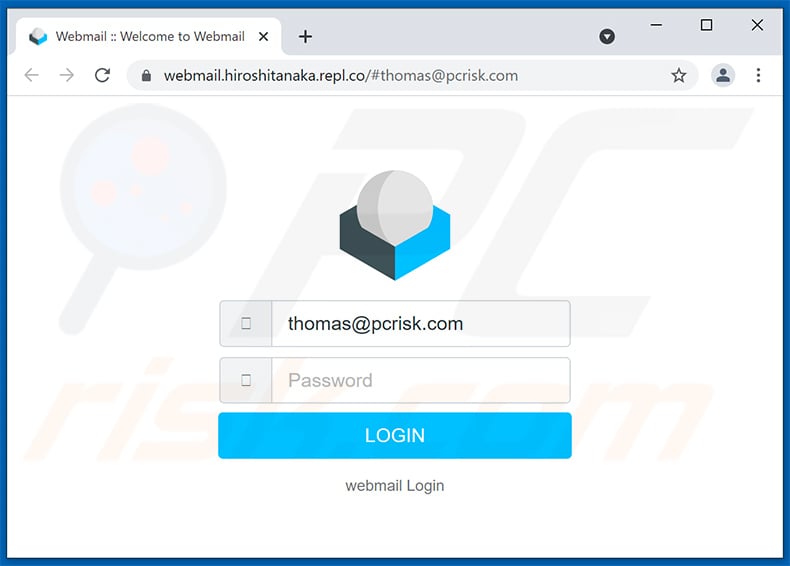
A Spanish variant of Webmail-themed spam email promoting a phishing site:
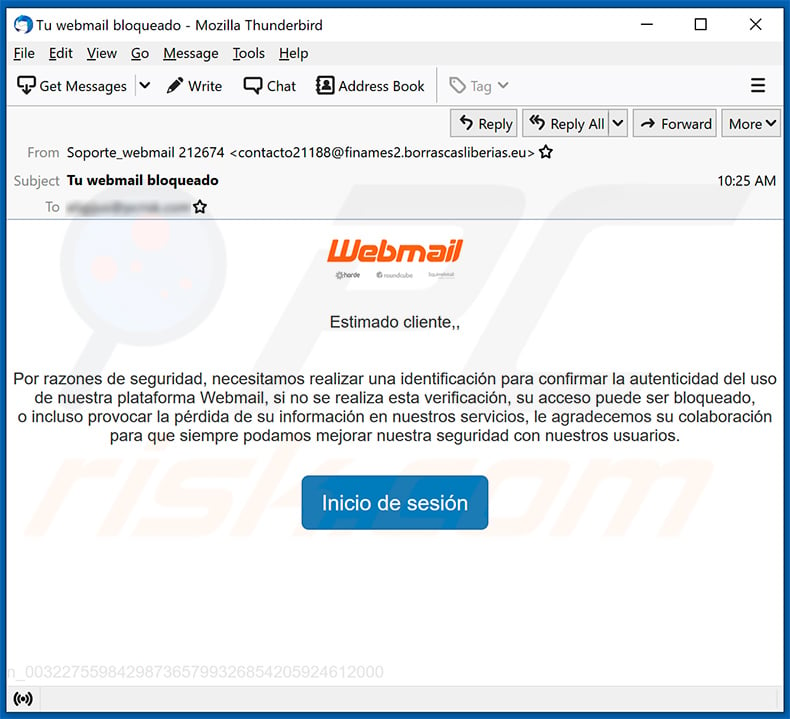
Text presented within:
Subject: Tu webmail bloqueado
Estimado cliente,,Por razones de seguridad, necesitamos realizar una identificación para confirmar la autenticidad del uso de nuestra plataforma Webmail, si no se realiza esta verificación, su acceso puede ser bloqueado,
o incluso provocar la pérdida de su información en nuestros servicios, le agradecemos su colaboración para que siempre podamos mejorar nuestra seguridad con nuestros usuarios.
Screenshot of the promoted phishing site (minutasara[.]eu):
![Webmail-themed phishing website promoted via email spam (2021-07-16 - minutasara[.]eu)](/images/stories/screenshots202107/webmail-scam-update-2021-07-16-phishing-site.jpg)
Another example of Webmail-themed spam email, this time claiming that recipient's password is about to expire:
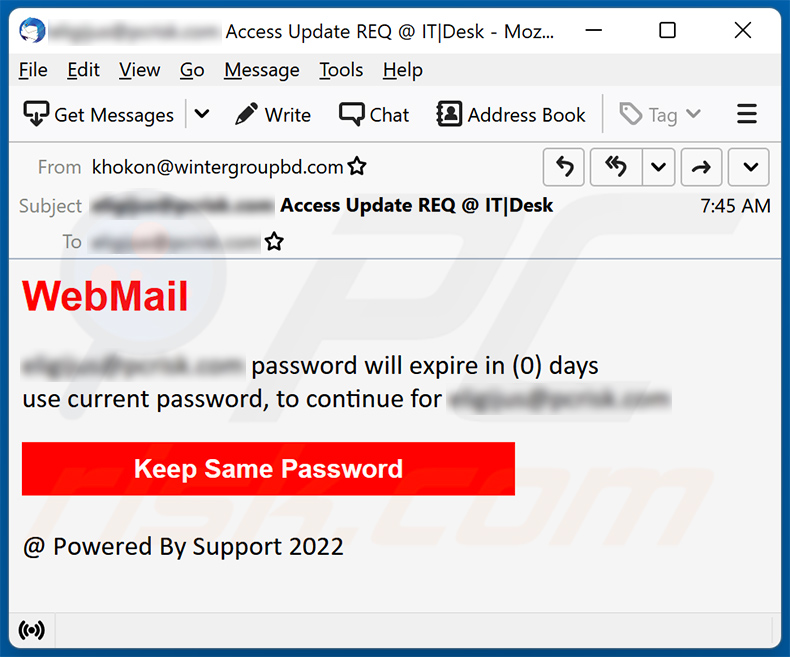
Text presented within:
Subject: ******** Access Update REQ @ IT|Desk
WebMail******** password will expire in (0) days
use current password, to continue for ********
Keep Same Password
@ Powered By Support 2022
Another example of Webmail-themed spam email promoting a phishing site:
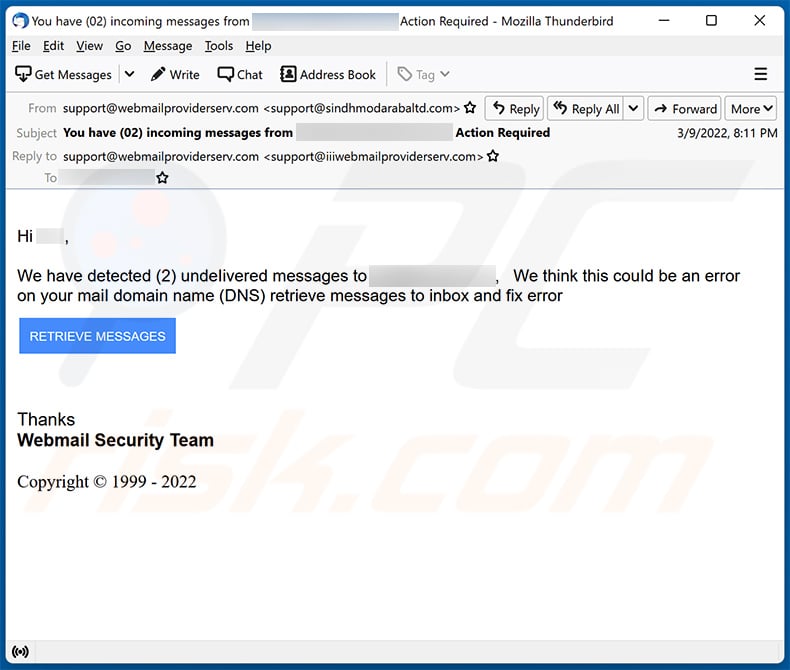
Text presented within:
Subject: You have (02) incoming messages from ******** Action Required
Hi ********,We have detected (2) undeIivered messages to ********, We think this couId be an error on your maiI domain name (DNS) retrieve messages to inbox and fix error
RETRIEVE MESSAGES
Thanks
Webmail Security TeamCopyright © 1999 - 2022
Yet another example of Webmail-themed spam email:
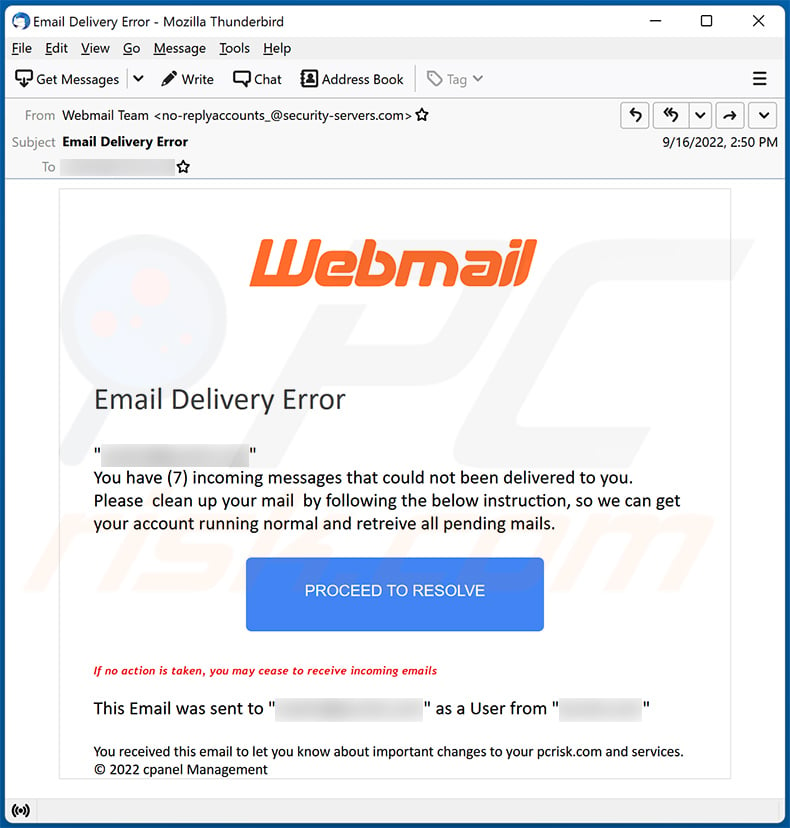
Text presented within:
Subject: Email Delivery Error
Webmail
Email Delivery Error
"-"
You have (7) incoming messages that could not been delivered to you.
Please clean up your mail by following the below instruction, so we can get your account running normal and retreive all pending mails.PROCEED TO RESOLVE
If no action is taken, you may cease to receive incoming emails
This Email was sent to "-" as a User from "-"You received this email to let you know about important changes to your - and services.
© 2022 cpanel Management
Yet another example of Webmail-themed spam email promoting a phishing site:
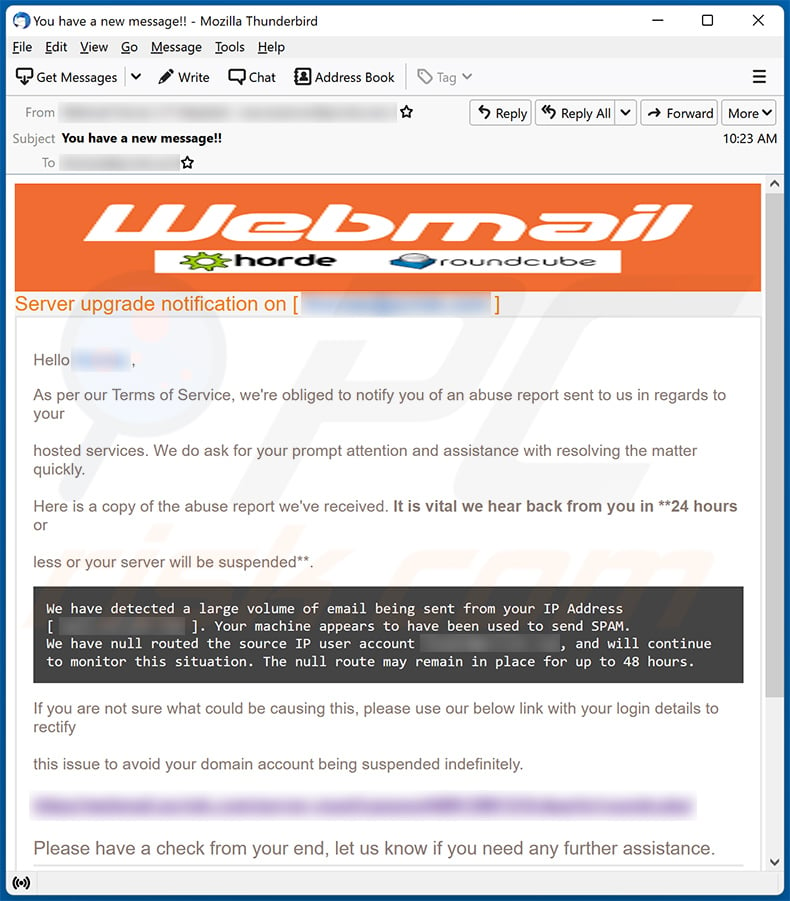
Text presented within:
Subject:Subject: You have a new message!!
Server upgrade notification on [ ******** ]Hello ********.,
As per our Terms of Service, we're obliged to notify you of an abuse report sent to us in regards to your
hosted services. We do ask for your prompt attention and assistance with resolving the matter quickly.
Here is a copy of the abuse report we've received. It is vital we hear back from you in **24 hours or
less or your server will be suspended**.
We have detected a large volume of email being sent from your IP Address
[ mail.******** ]. Your machine appears to have been used to send SPAM.
We have null routed the source IP user account ********, and will continue
to monitor this situation. The null route may remain in place for up to 48 hours.If you are not sure what could be causing this, please use our below link with your login details to rectify
this issue to avoid your domain account being suspended indefinitely.
-
Please have a check from your end, let us know if you need any further assistance.
This notice is made with the server address of “********” through the “cpanel” specification message service on the server.
Yet another example of an email from Webmail spam campaign:
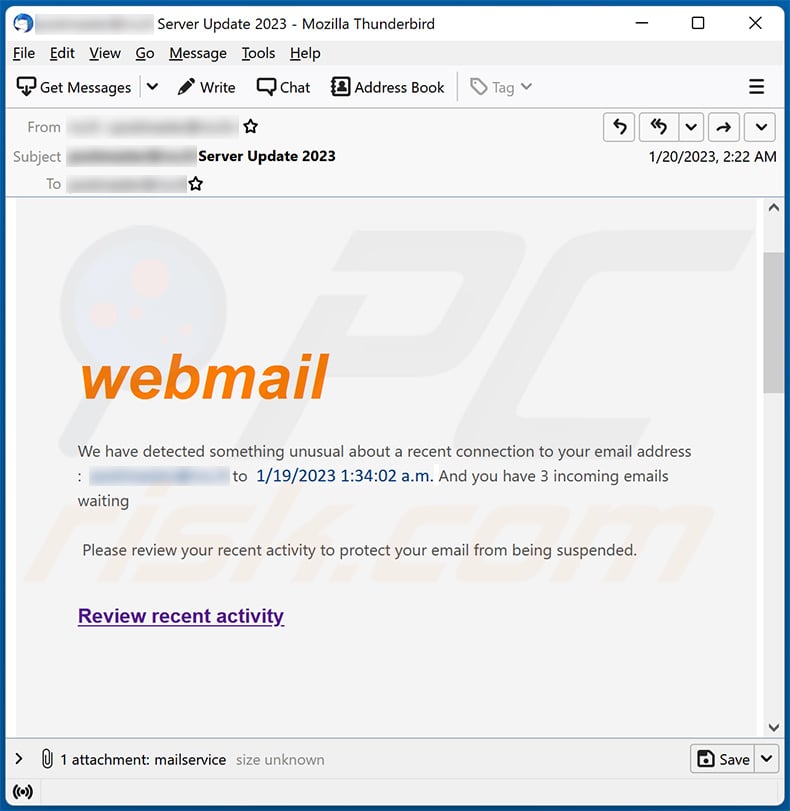
Text presented within:
Subject: ******** Server Update 2023
webmailWe have detected something unusual about a recent connection to your email address : ******** to 1/19/2023 1:34:02 a.m. And you have 3 incoming emails waiting
Please review your recent activity to protect your email from being suspended.
Review recent activity
Instant automatic malware removal:
Manual threat removal might be a lengthy and complicated process that requires advanced IT skills. Combo Cleaner is a professional automatic malware removal tool that is recommended to get rid of malware. Download it by clicking the button below:
DOWNLOAD Combo CleanerBy downloading any software listed on this website you agree to our Privacy Policy and Terms of Use. To use full-featured product, you have to purchase a license for Combo Cleaner. 7 days free trial available. Combo Cleaner is owned and operated by RCS LT, the parent company of PCRisk.com.
Quick menu:
- What is Webmail spam?
- Types of malicious emails.
- How to spot a malicious email?
- What to do if you fell for an email scam?
Types of malicious emails:
![]() Phishing Emails
Phishing Emails
Most commonly, cybercriminals use deceptive emails to trick Internet users into giving away their sensitive private information, for example, login information for various online services, email accounts, or online banking information.
Such attacks are called phishing. In a phishing attack, cybercriminals usually send an email message with some popular service logo (for example, Microsoft, DHL, Amazon, Netflix), create urgency (wrong shipping address, expired password, etc.), and place a link which they hope their potential victims will click on.
After clicking the link presented in such email message, victims are redirected to a fake website that looks identical or extremely similar to the original one. Victims are then asked to enter their password, credit card details, or some other information that gets stolen by cybercriminals.
![]() Emails with Malicious Attachments
Emails with Malicious Attachments
Another popular attack vector is email spam with malicious attachments that infect users' computers with malware. Malicious attachments usually carry trojans that are capable of stealing passwords, banking information, and other sensitive information.
In such attacks, cybercriminals' main goal is to trick their potential victims into opening an infected email attachment. To achieve this goal, email messages usually talk about recently received invoices, faxes, or voice messages.
If a potential victim falls for the lure and opens the attachment, their computers get infected, and cybercriminals can collect a lot of sensitive information.
While it's a more complicated method to steal personal information (spam filters and antivirus programs usually detect such attempts), if successful, cybercriminals can get a much wider array of data and can collect information for a long period of time.
![]() Sextortion Emails
Sextortion Emails
This is a type of phishing. In this case, users receive an email claiming that a cybercriminal could access the webcam of the potential victim and has a video recording of one's masturbation.
To get rid of the video, victims are asked to pay a ransom (usually using Bitcoin or another cryptocurrency). Nevertheless, all of these claims are false - users who receive such emails should ignore and delete them.
How to spot a malicious email?
While cyber criminals try to make their lure emails look trustworthy, here are some things that you should look for when trying to spot a phishing email:
- Check the sender's ("from") email address: Hover your mouse over the "from" address and check if it's legitimate. For example, if you received an email from Microsoft, be sure to check if the email address is @microsoft.com and not something suspicious like @m1crosoft.com, @microsfot.com, @account-security-noreply.com, etc.
- Check for generic greetings: If the greeting in the email is "Dear user", "Dear @youremail.com", "Dear valued customer", this should raise suspiciousness. Most commonly, companies call you by your name. Lack of this information could signal a phishing attempt.
- Check the links in the email: Hover your mouse over the link presented in the email, if the link that appears seems suspicious, don't click it. For example, if you received an email from Microsoft and the link in the email shows that it will go to firebasestorage.googleapis.com/v0... you shouldn't trust it. It's best not to click any links in the emails but to visit the company website that sent you the email in the first place.
- Don't blindly trust email attachments: Most commonly, legitimate companies will ask you to log in to their website and to view any documents there; if you received an email with an attachment, it's a good idea to scan it with an antivirus application. Infected email attachments are a common attack vector used by cybercriminals.
To minimise the risk of opening phishing and malicious emails we recommend using Combo Cleaner Antivirus for Windows.
Example of a spam email:

What to do if you fell for an email scam?
- If you clicked on a link in a phishing email and entered your password - be sure to change your password as soon as possible. Usually, cybercriminals collect stolen credentials and then sell them to other groups that use them for malicious purposes. If you change your password in a timely manner, there's a chance that criminals won't have enough time to do any damage.
- If you entered your credit card information - contact your bank as soon as possible and explain the situation. There's a good chance that you will need to cancel your compromised credit card and get a new one.
- If you see any signs of identity theft - you should immediately contact the Federal Trade Commission. This institution will collect information about your situation and create a personal recovery plan.
- If you opened a malicious attachment - your computer is probably infected, you should scan it with a reputable antivirus application. For this purpose, we recommend using Combo Cleaner Antivirus for Windows.
- Help other Internet users - report phishing emails to Anti-Phishing Working Group, FBI’s Internet Crime Complaint Center, National Fraud Information Center and U.S. Department of Justice.
Frequently Asked Questions (FAQ)
Why did I receive this email?
It is likely that your email address has been leaked and was used by scammers in a mass-email campaign. These types of letters are not personalized, as the same messages are sent to multiple recipients.
I have provided my personal information when tricked by this email, what should I do?
If you have provided your login credentials (e.g., username and password), change all passwords immediately. If you have provided credit card details, ID card information, or other sensitive information, contact the corresponding authorities as soon as possible.
I have downloaded and opened a file attached to an email, is my computer infected?
If the file you opened is executable, then it is likely that your computer is infected. However, if you opened a document like .pdf or .doc, or another type of file, it is possible that your computer is not infected since opening files is often not enough for malware to infect the system.
I have read the email but did not open the attachment, is my computer infected?
It can only be harmful when recipients click on links within emails or open attachments. Simply opening emails is harmless.
Will Combo Cleaner remove malware infections that were present in email attachment?
Yes, Combo Cleaner can detect and remove almost all known malware. High-end malware can hide deep in the system. Thus, running a full system scan is a must to eliminate it.
Share:

Tomas Meskauskas
Expert security researcher, professional malware analyst
I am passionate about computer security and technology. I have an experience of over 10 years working in various companies related to computer technical issue solving and Internet security. I have been working as an author and editor for pcrisk.com since 2010. Follow me on Twitter and LinkedIn to stay informed about the latest online security threats.
PCrisk security portal is brought by a company RCS LT.
Joined forces of security researchers help educate computer users about the latest online security threats. More information about the company RCS LT.
Our malware removal guides are free. However, if you want to support us you can send us a donation.
DonatePCrisk security portal is brought by a company RCS LT.
Joined forces of security researchers help educate computer users about the latest online security threats. More information about the company RCS LT.
Our malware removal guides are free. However, if you want to support us you can send us a donation.
Donate
▼ Show Discussion